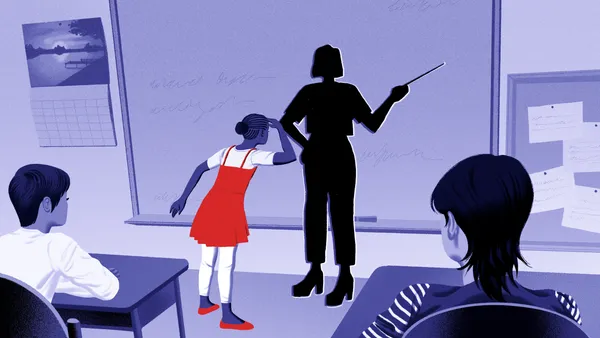Staffed Up is a monthly series examining school staffing best practices and solutions for teacher recruitment and retention. Catch up on previous installments here.
A K-12 Dive analysis of federal data shows that student-teacher ratios dropped in most states — 43 out of 51 — between the 2018-19 and 2022-23 school years, meaning there were on average fewer students per teacher post-COVID-19 than before the pandemic.
Overall, the national student-teacher ratio decreased from 16 to 15.4 students per teacher between 2018-19 and 2022-23, according to the National Center for Education Statistics' Common Core of Data.
Student-teacher ratios shrink in most states post-COVID-19
The result is there’s “not necessarily a shortage of teachers nationwide,” said Chad Aldeman, an independent researcher and author who analyzes teacher workforce data. Aldeman previously worked in the U.S. Department of Education under the Obama administration and is the former policy director at Georgetown University’s Edunomics Lab.
Only eight states — Alabama, Alaska, Florida, Minnesota, Nebraska, North Dakota, Oklahoma and Vermont — saw more students per teacher, and therefore fewer teachers overall in 2022-23 than they had pre-pandemic, according to our analysis of the NCES data.
The states showing the most extreme increase in student-teacher ratios — Alaska and Florida — likely still grapple with teacher shortages, Aldeman said.
On the flip side, in most states where student-teacher ratios decreased, Aldeman said it’s likely those areas actually have a surplus of teachers.
A historic amount of federal emergency aid flowed to schools over the past few years in response to the pandemic. Some localities used the funds to increase teaching and student support staff. Now, as that funding dries up, conversations about teacher vacancies may pivot to ones about attrition and layoff strategies.
“We had this conversation about vacancies and shortages for the last few years and now that conversation is going to have to turn over the next 12 to 18 months,” Aldeman said. That's because teacher hiring is slowing, and educator vacancies are becoming fewer, he said.
“There may still be vacancies and shortages," he said. But "they’re going to be smaller, they’re going to be more concentrated," in common hard-to-staff roles, such as special education, science or math.
In analyzing NCES’ Common Core of Data, Aldeman said he found roughly 3 of 4 school districts reduced their student-teacher ratios post-pandemic — reflecting the trend seen at the state level.
Below we provide a snapshot from K-12 Dive's analysis of how the needle has moved broadly on student-teacher ratios across states.
To help you see how student-teacher ratios have changed in your state and others, we've presented the NCES data in the map above and chart below.







 Dive Awards
Dive Awards


